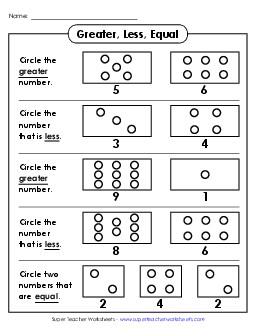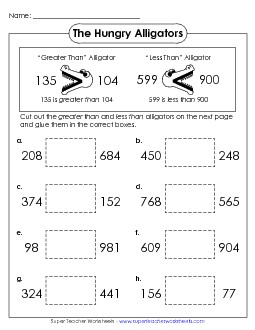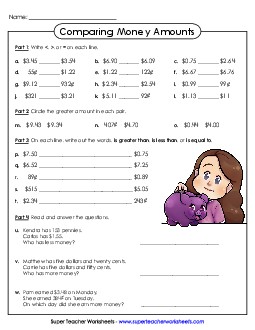Greater Than / Less Than Worksheets

Compare single-digit numbers with mathematical symbols on these free worksheets. Also includes worksheets on using words more and fewer. Illustrations on many worksheets require counting.
2-Digit Numbers: Comparing and OrderingOn this page, you'll find a large selection of worksheets on comparing and ordering 2-digit numbers. Teach students how to use the greater than, less than, and equal to math symbols. Includes a couple math games and learning centers, as well as worksheets.
3-Digit Numbers: Comparing and OrderingThis page has printables for ordering and comparing triple-digit numbers. Includes worksheets, task cards, a classroom games, a cut-and-glue alligator activity, and more.
4-Digit Numbers: Ordering and ComparingLearn about "greater than", "less than", and "equal to" with these printable teaching resources. All include numbers up to four digits.
5-Digit Numbers: Comparing and OrderingDownload task cards, classroom games, worksheets for teaching students about ordering and comparing the values of five-digit numbers.
6-Digit Numbers: Comparing and OrderingUse the mathematical symbols for "equal to," "less than," and "greater than" to compare numbers. Also, order numbers from least to greatest.
Fractions: Comparing and OrderingDownload these activities if you're teaching your class about ordering and comparing fractions and mixed numbers.
Decimals: Comparing and OrderingOn these printables, pupils will use the symbols <, >, and = to compare decimal values.
Money: ComparingCompare pairs of money amounts. (example: $1.56 < $1.46) Includes worksheets and a math card game learning center.
Place ValueHere's our main place value page, which has a variety of resources that can help students learn about digit values, place value blocks, reading numbers, and expanded form.
Rational NumbersThese worksheets help students practice various concepts related to rational numbers, including comparing and ordering a mix of decimals, fractions, and whole numbers.
RoundingThis set of teaching resources will help students learn about rounding to the nearest ten, hundred, thousand, tenth, and hundredth.
InequalitiesThis index page features middle-school level worksheets on inequalities.



The ability to compare and order numbers is foundational to all other math skills. These concepts are introduced as early as kindergarten through learning to identify “bigger” and “smaller” numbers. Students continue to develop their number sense through the upper elementary years by using comparison symbols—such as > (greater than), < (less than), and = (equal to)—to evaluate and communicate number relationships. This skill initially focuses on determining the relative size of whole numbers, recognizing the scaling of place value, ordering numbers from least to greatest or greatest to least, and comparing simple numeric and arithmetic expressions.
As students advance, they encounter more complex comparison tasks involving fractions, decimals, money, and even negative numbers. Each is linked to a number of other skills. Comparing fractions requires students to understand concepts like equivalent fractions and common denominators, while comparing decimals involves recognizing the relative value of digits in different decimal places. Comparing money amounts and working with negative numbers helps students grasp real-world applications of math, including evaluating prices, budgeting, and understanding financial transactions. These skills are crucial not only for a range of academic tasks but also for everyday problem-solving and decision-making.
When it comes to teaching kids how to order and compare numbers, aids such as the number lines and place value charts available on Super Teacher Worksheets are key to visualizing numbers’ relative sizes with physical positioning. STW also has a selection of free printable worksheets for early learners to help understand number values. Many can be paired with manipulatives like base-ten blocks or fraction strips to provide hands-on learning opportunities. Activities such as number sorting games, math centers with physical comparison symbols, and real-life-scenario word problems can make learning these essential math skills fun and relevant.






